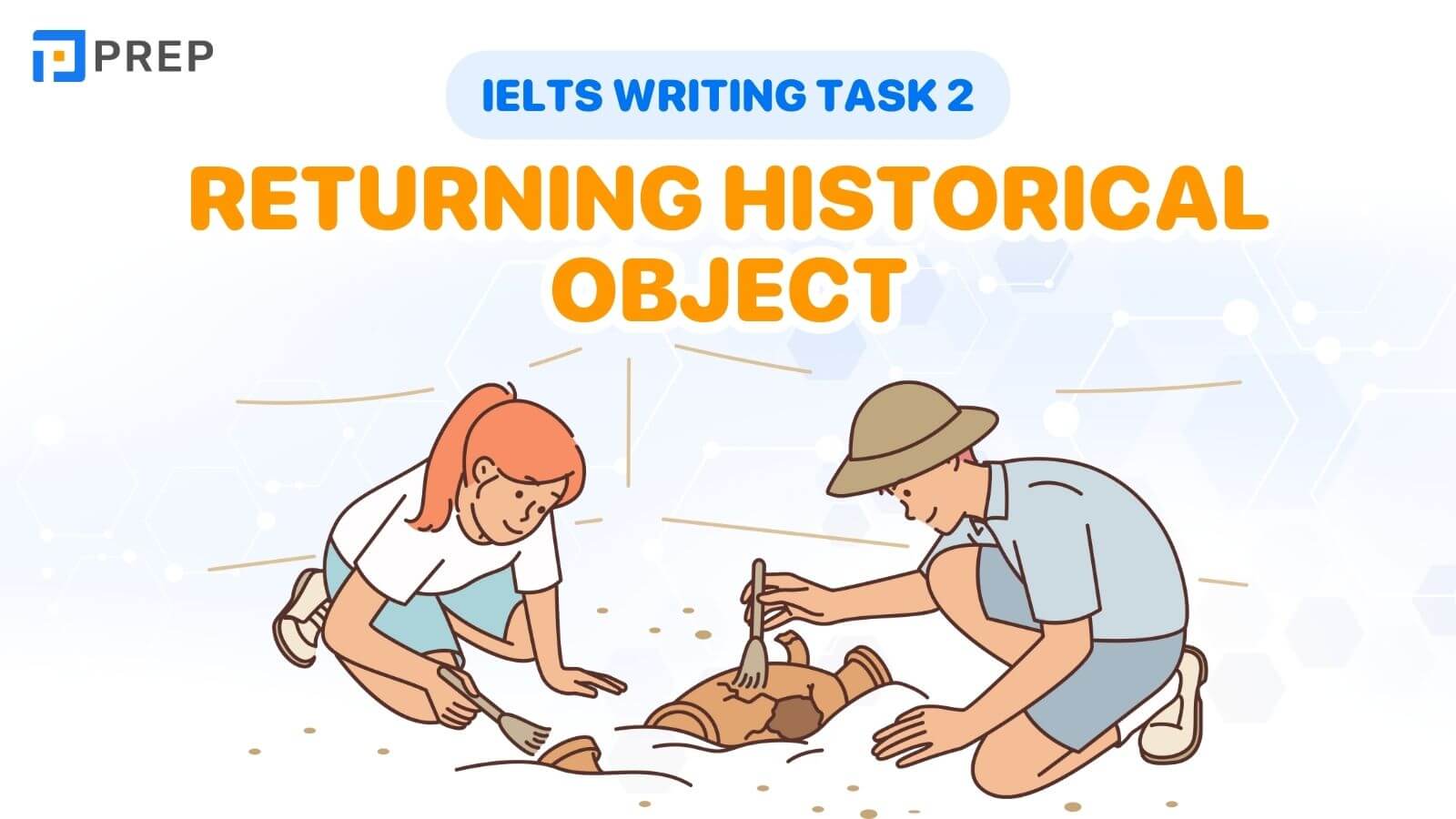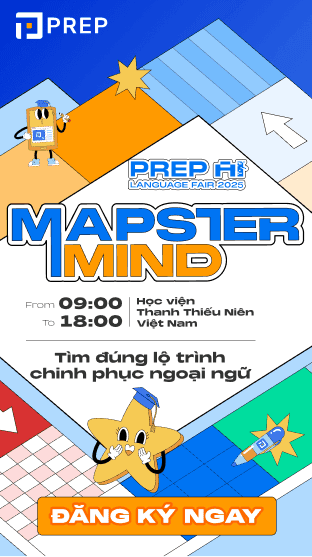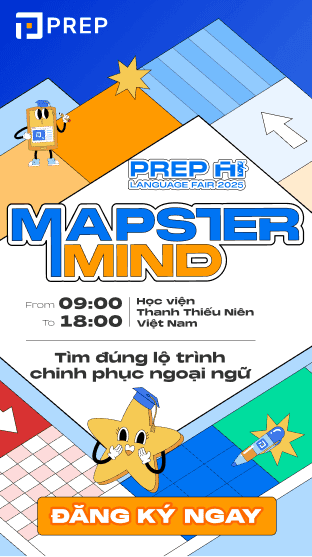Đề bài, bài mẫu IELTS Writing Task 2 chủ đề: Returning historical objects
Returning historical objects - đề bài Writing Task 2 thực chiến được sử dụng để kiểm tra khả năng Viết của thí sinh trong ngày 22/05/2023. Nếu gặp chủ đề này, bạn sẽ xử lý như thế nào để chinh phục được band điểm mục tiêu? Tham khảo ngay phân tích, dàn bài và bài mẫu band 8.0+ được biên soạn bởi thầy Nhật Phạm - giáo viên hạng A tại prepedu.com để luyện thi hiệu quả nhé!
[caption id="attachment_34004" align="aligncenter" width="500"] Bài mẫu IELTS Writing Task 2 Returning historical objects[/caption]
Bài mẫu IELTS Writing Task 2 Returning historical objects[/caption]
I. Đề bài IELTS Writing Task 2 Returning historical objects
Đề thi IELTS Writing Task 2 Returning historical objects ngày 22/5/2023: Historical objects should be brought back to their country of origin. To what extent do you agree or disagree? Give reasons for your answer and include any relevant examples from your own knowledge or experience.
[caption id="attachment_34005" align="aligncenter" width="1504"] Đề bài IELTS Writing Task 2 Returning historical objects[/caption]
Đề bài IELTS Writing Task 2 Returning historical objects[/caption]
II. Gợi ý giải đề & dàn bài IELTS Writing Task 2 Returning historical objects
1. Phân tích đề thi
Theo đánh giá của thầy Nhật Phạm - giáo viên chấm bài tại prepedu.com thì IELTS Writing Task 2 Returning historical objects là đề thi có độ khó cao. Thí sinh sẽ gặp đôi chút thử thách trong việc tìm ý tưởng, vì cách diễn đạt câu hỏi trong đề IELTS Writing Task 2 Returning historical objects có thể gây nhầm lẫn.
Do đó, cần tránh biến toàn bộ bài thành so sánh advantages & disadvantages trong việc trả lại các hiện vật lịch sử về quốc gia xuất xứ. Đây là các cách lạc đề gây mất điểm phổ biến đối với đề IELTS Writing Task 2 Returning historical objects. Nếu chọn viết theo hướng này, cần phải dẫn dắt được việc advantages > disadvantages (hay ngược lại) là lý do chính để đồng ý (hay không) với quan điểm trong đề bài IELTS Writing Task 2 Returning historical objects.
2. Dàn bài chi tiết
Tham khảo dàn bài IELTS Writing Task 2 Returning historical objects dưới đây để tự viết bài thi tại nhà bạn nhé!
| Introduction |
|
| Benefits of bringing back historical objects to their country of origin |
|
| Drawbacks of bringing back historical objects to their country of origin and why drawbacks outweigh the benefits |
|
| Conclusion & Opinion |
|
III. Bài mẫu IELTS Writing Task 2 Returning historical objects
Bài mẫu IELTS Writing Task 2 Returning historical objects được biên soạn bởi thầy Nhật Phạm - Marking Leader tại prepedu.com. Tham khảo để ôn luyện thi IELTS Writing hiệu quả Preppies nhé!
The repatriation of historical objects has been a contentious issue for many years, with some arguing that these artifacts should be returned to their country of origin, as opposed to others, who believe that they should remain in their current location. Despite some merits of reinstating original ownership of relics, I am inclined to disagree with this course of action.
Repatriation can be beneficial to an extent. Initially, it can help to restore a sense of national identity, as the objects are seen as a symbol of the country’s history and culture. This is certainly the case with nations whose history is rich, such as Egypt or Greece, but whose artifacts are in exhibition thousands of miles away. Repatriation, furthermore, may ensure that the objects are well-preserved, as they may be better cared for in their home country than in their current location. When the people who preside over ancient relics feel connected to the objects’ origin, they would undoubtedly be committed to their protective responsibilities. It could, therefore, be argued that all artifacts deserve repatriation.
However, this idea is not always positive or practical. Firstly, the effort can be expensive, as the relics would need to be shipped to their country of origin to be stored. Statues, for example, are noticeably challenging to handle, as their sizes may not fit cargo planes, while their structural integrity may be compromised while traveling on the sea due to the environment. In addition, there may be competing claims from different countries over certain artifacts, resulting in difficulty in determining the rightful owner. A diplomatic row might end up sparking between various nations because of such a small issue, straining international relations. Taking these points into consideration, I would argue that the downsides of repatriation overshadow the gains.
In conclusion, while this idea warrants some merit, I generally disagree with returning every single historical artifact to its home country. Restoring original ownership, ultimately, should be based on a careful assessment of the costs and benefits, as well as the legal and ethical issues involved.
Từ vựng sử dụng trong bài mẫu IELTS Writing Task 2 Returning historical objects:
- Repatriation (n.): trả về chính chủ
- Artifact (n.): hiện vật
- Symbol (n.): biểu tượng
- Well-preserved (adj.): được bảo quản tốt
- Handle (v.): xử lý
- Cargo plane (n.): máy bay chở hàng
- Structural integrity (n.): tính toàn vẹn cấu trúc
- Compromised (adj.): bị hư hỏng
- Claim (n.): lời khiếu nại, đòi
- Diplomatic row (n.): tranh chấp ngoại giao
- Spark (v.): bùng phát
- International relations (v.): quan hệ quốc tế
- Warrant sth (v.): xứng đáng nhận điều gì đó
- Legal (adj.): về mặt pháp lý
- Ethical (adj.): về mặt đạo đức
Tham khảo thêm bài viết:
Đề bài, bài mẫu IELTS Writing Task 2 chủ đề: Customs and behaviours
Trên đây là toàn bộ phân tích, dàn bài và bài mẫu IELTS Writing Task 2 Returning historical objects band 8.0+ được biên soạn bởi giáo viên hạng A tại prepedu.com. Tham khảo kỹ lưỡng để luyện thi IELTS Writing hiệu quả tại nhà bạn nhé. Chúc Preppies sớm chinh phục được điểm số mục tiêu trong kỳ thi thực chiến sắp tới!

Chào bạn! Mình là Hiền Hoàng, hiện đang đảm nhận vai trò quản trị nội dung sản phẩm tại Blog của website prepedu.com.
Với hơn 5 năm tự học các ngoại ngữ như tiếng Anh, tiếng Trung và ôn luyện một số kỳ thi IELTS, TOEIC, HSK, mình đã tự đúc rút được nhiều kinh nghiệm để hỗ trợ hàng nghìn người đang gặp khó khăn trong việc học ngoại ngữ. Hy vọng rằng những chia sẻ phía trên sẽ giúp ích cho bạn trong quá trình tự ôn luyện thi hiệu quả tại nhà!
Bình luận
Nội dung premium
Xem tất cảLộ trình cá nhân hoá
Có thể bạn quan tâm
Kết nối với Prep

MSDN: 0109817671.
Địa chỉ liên hệ: Tòa nhà Vinaconex, 34 Láng Hạ, phường Láng, TP Hà Nội.
Trung tâm CSKH tại HN: Lô 21 C2 Khu đô thị Nam Trung Yên, phường Yên Hòa, TP Hà Nội.
Trung tâm CSKH tại HCM: 288 Pasteur, Phường Xuân Hòa, TP Hồ Chí Minh
Trụ sở Công ty: Số nhà 20, ngách 234/35 đường Hoàng Quốc Việt, phường Nghĩa Đô, TP Hà Nội.
Phòng luyện ảo - Trải nghiệm thực tế - Công nghệ hàng đầu.
Hotline: 0931 42 8899.
Trụ sở Công ty: Số nhà 20, ngách 234/35 đường Hoàng Quốc Việt, phường Nghĩa Đô, TP Hà Nội.
Giấy chứng nhận hoạt động đào tạo, bồi dưỡng số 1309/QĐ-SGDĐT ngày 31 tháng 07 năm 2023 do Sở Giáo dục và Đào tạo Hà Nội cấp.

























